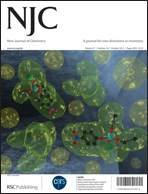Gene delivery agents possessing antiradical activity: self-assembling cationic amphiphilic 1,4-dihydropyridine derivatives†
Abstract
Seventeen 1,4-dihydropyridine (1,4-DHP) amphiphiles including differently substituted pyridinium, pyrazinium, N-methyl piperidinium or N-methyl morpholinium moieties as the cationic head-group of the molecule have been designed and synthesised. 1,4-DHP amphiphiles have been earlier proposed as a promising tool for plasmid DNA (pDNA) delivery in vitro. In this work the ability of the 1,4-DHP amphiphiles to self-assemble, to bind pDNA and to transfer it into the cells as well as the cytotoxicity of 1,4-DHP amphiphiles–pDNA complexes was studied. Furthermore, antiradical activity (ARA) of the 1,4-DHP derivatives was determined. We have revealed that all new 1,4-DHP amphiphiles possessed self-assembling properties and formed nanoparticles in an aqueous environment. The structure of the cationic head-group of 1,4-DHP amphiphiles influenced the size of nanoparticles. Additionally, we demonstrated for the first time that the electronic nature of the substituent of the pyridinium as the cationic head-group of the 1,4-DHP amphiphiles strongly affected the ability of these compounds to bind pDNA and transfer it into the cells. The amphiphiles with electron-donating properties possessing substituents at pyridinium moieties were able to bind pDNA and to deliver it more efficiently than amphiphiles containing electron-withdrawing properties possessing substituents at pyridinium moieties. Moreover, in this study we have established that the presence of the cationic part in the molecule was essential for the expression of ARA among tested 1,4-DHP amphiphiles. Cationic 1,4-DHP derivatives containing pyrazinium or N-methyl morpholinium substituents in the cationic head-group of the molecule displayed the highest ARA.


 Please wait while we load your content...
Please wait while we load your content...